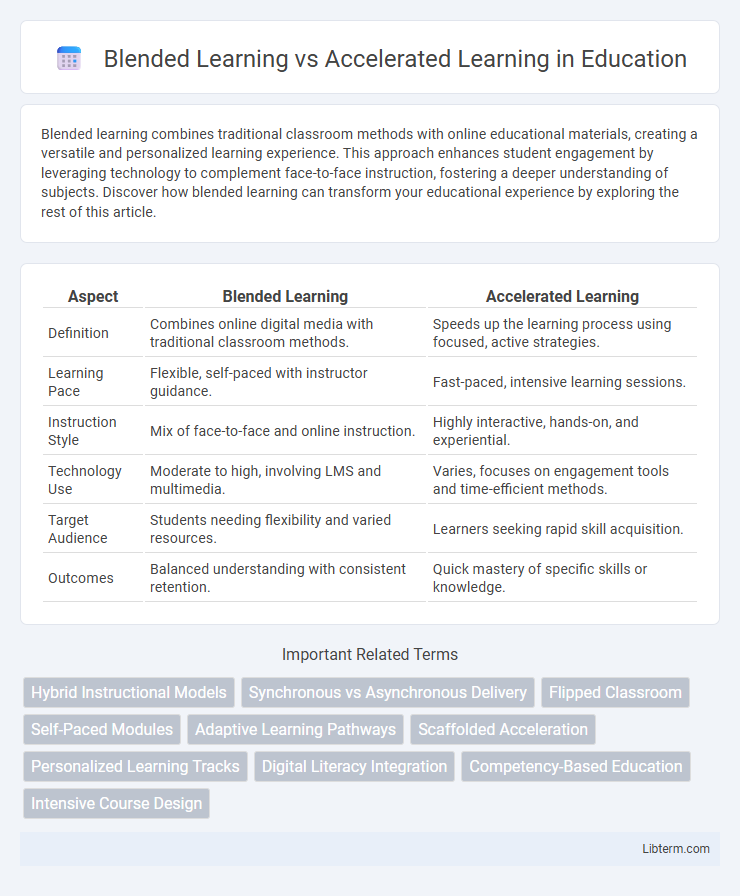Blended learning combines traditional classroom methods with online educational materials, creating a versatile and personalized learning experience. This approach enhances student engagement by leveraging technology to complement face-to-face instruction, fostering a deeper understanding of subjects. Discover how blended learning can transform your educational experience by exploring the rest of this article.
Table of Comparison
| Aspect | Blended Learning | Accelerated Learning |
|---|---|---|
| Definition | Combines online digital media with traditional classroom methods. | Speeds up the learning process using focused, active strategies. |
| Learning Pace | Flexible, self-paced with instructor guidance. | Fast-paced, intensive learning sessions. |
| Instruction Style | Mix of face-to-face and online instruction. | Highly interactive, hands-on, and experiential. |
| Technology Use | Moderate to high, involving LMS and multimedia. | Varies, focuses on engagement tools and time-efficient methods. |
| Target Audience | Students needing flexibility and varied resources. | Learners seeking rapid skill acquisition. |
| Outcomes | Balanced understanding with consistent retention. | Quick mastery of specific skills or knowledge. |
Understanding Blended Learning
Blended learning combines traditional classroom instruction with online educational materials and interactive activities, enhancing flexibility and personalized learning experiences. This approach leverages digital tools to support diverse learning styles, enabling students to access content anytime and progress at their own pace. Key components include face-to-face interaction, e-learning modules, and collaborative projects, which together improve engagement and knowledge retention.
Exploring Accelerated Learning
Accelerated learning leverages intensive, focused techniques such as spaced repetition, active recall, and immersive experiences to rapidly deepen understanding and skill acquisition. Unlike blended learning that combines online and in-person instruction over extended periods, accelerated learning emphasizes speed and efficiency by condensing curriculum into shorter timeframes with high engagement. Techniques like multisensory learning and real-world application are critical in accelerating knowledge retention and mastery.
Core Differences Between Blended and Accelerated Learning
Blended learning combines traditional face-to-face instruction with online educational activities to create a flexible and interactive learning environment. Accelerated learning focuses on strategies that significantly shorten the time needed to acquire knowledge by enhancing cognitive absorption through techniques such as multimedia use, active engagement, and memory reinforcement. The core difference lies in blended learning's delivery method integrating multiple modalities, while accelerated learning emphasizes speed and efficiency in mastering content.
Key Benefits of Blended Learning
Blended learning combines traditional face-to-face instruction with online educational resources, enhancing flexibility and personalized learning experiences for diverse student needs. Key benefits include improved student engagement through interactive digital content, increased accessibility to course materials anytime and anywhere, and the ability to track and analyze learner progress with real-time data analytics. This approach supports better retention rates and fosters collaboration by integrating synchronous and asynchronous learning environments.
Advantages of Accelerated Learning
Accelerated learning offers the advantage of significantly reducing the time required to acquire new skills or knowledge, making it ideal for fast-paced environments and learners with tight schedules. This approach leverages techniques such as spaced repetition, active recall, and multimodal instruction to enhance retention and comprehension effectively. Accelerated learning also promotes increased learner engagement and motivation by tailoring content to individual learning styles and focusing on intensive, goal-oriented study sessions.
Challenges and Limitations of Each Approach
Blended learning faces challenges such as the need for reliable technological infrastructure and the risk of student disengagement due to inconsistent online and in-person integration. Accelerated learning often struggles with high cognitive load and limited time for deep comprehension, which can lead to surface-level understanding and increased stress. Both approaches require careful instructional design to mitigate their limitations and maximize learner outcomes.
Ideal Learning Scenarios for Blended Learning
Blended learning excels in ideal scenarios where learners benefit from a combination of face-to-face interaction and flexible online resources, such as corporate training programs and higher education courses that require both theoretical knowledge and practical application. This approach supports diverse learning styles by integrating synchronous classroom engagement with asynchronous digital content, fostering collaboration and self-paced study. Institutions with access to robust technology infrastructure and a need for scalable, personalized instruction often find blended learning the most effective for improving learner retention and skill acquisition.
When to Choose Accelerated Learning
Accelerated learning is ideal when time constraints demand rapid skill acquisition or knowledge mastery, such as during corporate training or certification preparation. This approach leverages intensive, focused sessions and personalized techniques to optimize retention and application speed. Choosing accelerated learning benefits learners aiming for quick results without compromising comprehension depth.
Impact on Student Engagement and Performance
Blended learning combines online and face-to-face instruction, enhancing student engagement by offering flexible access to diverse resources and interactive activities, which often leads to improved academic performance. Accelerated learning techniques focus on speeding up the acquisition of knowledge through intense, focused instruction and active learning strategies, boosting student motivation and retention rates. Both approaches positively impact student engagement and performance, with blended learning fostering sustained involvement and accelerated learning driving rapid comprehension and application.
Future Trends in Modern Educational Methods
Blended learning integrates technology with traditional classroom instruction, creating a flexible and personalized educational experience that adapts to diverse learning styles. Accelerated learning emphasizes rapid skill acquisition through immersive techniques and intensive practice, often leveraging AI-driven tools to optimize cognitive engagement. Future trends highlight the convergence of these methods, with adaptive learning platforms harnessing data analytics and virtual reality to enhance efficiency and accessibility in education.
Blended Learning Infographic

 libterm.com
libterm.com